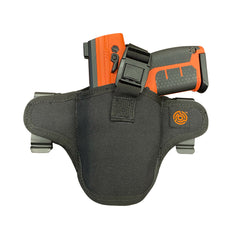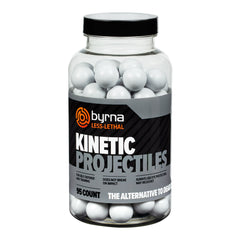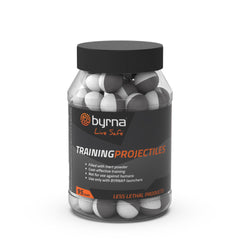
Safety doesn't announce itself with warning signs. One minute, the highway stretches quietly before you, and then suddenly, your engine sputters, and the shoulder vanishes into darkness. During those tense moments between thinking, "What now?" and "I can handle this," the equipment within your reach determines how your night unfolds. According to FEMA surveys, most drivers carry nothing beyond jumper cables - and sometimes not even those. The other necessary supplies, particularly personal protection items to help during interactions with strangers, almost never find their way into your trunk.
A car go-bag fills that safety gap in your preparation. Water pouches, energy bars, and a compact medical kit create the foundation. But the bag proves its worth with tools most people miss - a metal whistle loud enough to cut through traffic noise, a rechargeable flashlight that works as a strobe signal, and pepper spray or a piercing personal alarm. These items weigh very little. They save important seconds when you need to unclip, grab, and respond before someone comes toward your vehicle. You should arrange these items at the top of your bag, not hidden under jumper cables and duct tape.
Let's talk about how to put your kit together, test it out, and make adjustments as needed. What matters is that the next time your headlights start to dim, and everything around you seems too quiet, reaching for help is as easy as unzipping your emergency bag!
Table of Contents
Which Survival Items Should You Pack?
Roadside emergencies don't usually look anything like those flat-tire drills you practiced in driver's education.
Your jumper cables still matter. Think of this bag as a small support system that sits in your trunk, ready for when your normal day suddenly changes course. If you put it together properly and check it every six months, you're going to feel more confident every time you drive.
Your go-bag should have the basic items your body needs most immediately. Try to have at least one liter of water for each seat in your vehicle stored in sturdy bottles that you replace every six months before they start to taste like plastic. You should also pack foods that withstand summer heat and winter cold - items like unsalted nuts, protein bars, and chewy dried fruit. These snacks take up minimal space, digest slowly, and give you steady energy without the crash you might get from sugary alternatives.

A basic first-aid kit works as a starting point, not your full medical fix. You can improve it by adding instant cold packs, pain relievers that work for you, and about a week's worth of any prescription medications you depend on. For anyone with asthma, bad allergies, or chronic pain, remember to pack what you need to manage these conditions. When a migraine or sprained ankle makes your car problems worse, you're going to feel relieved that your emergency kit includes your personal health needs.
Darkness makes visibility your number one safety concern - it determines if help sees you or drives right past. You should attach a water-resistant LED flashlight to your bag, preferably one with a red beacon setting and a battery life that lasts for a few days. The light serves two purposes - it helps you make repairs under the hood and alerts passing traffic when you're stranded on a dark roadside. Your reflective vest and roadside flares might help. But they're much less effective than a bright beam of light.
You need a backup communication plan because cell towers can fall during storms, phone batteries run out, and coverage maps aren't always accurate. A hand-crank or battery-powered NOAA radio lets you stay connected to weather updates and emergency information when your phone can't get a signal. Even the simplest models give warnings relevant to your area, helping you determine whether to wait out bad weather or continue driving before conditions worsen.
Finish your emergency kit with tools designed for those panic-inducing situations. A quality multi-tool combines a glass breaker and seat-belt cutter with pliers strong enough to pull out a fuse if you need it. You should add a compact tire plug and inflator set because a small puncture shouldn't force you into changing your spare tire on a narrow shoulder. These tools can change what could have been a big emergency into just a minor delay instead of requiring a full rescue team.
Which Defense Options Can You Carry?
Your self-defense gear that works well at home might suddenly become illegal when you travel across state lines, so you should always research the laws first. Each state creates its own regulations and updates them without much warning - something completely legal during your last trip could get you in trouble now. Take pepper spray. In California, your canister needs to be under 2.5 ounces - anything bigger gives a police officer who pulls you over for a minor violation a reason to take your protection tools or give you a fine. As you travel eastward, the laws change once again. Texas lets you carry most blunt-force tools. But you can't bring that same baton into schools, courthouses, or government buildings. Your physical location on the sidewalk might not change. But the legal situation beneath your feet does.
Since these laws always change, plenty of travelers choose equipment that hardly ever creates legal problems. A personal alarm works as an effective alternative - it fits in your palm, needs no training, and doesn't need any permits. You just pull a pin or push a button to create a loud shriek that gives you time while everyone nearby turns to look. These alarms remain quiet until activated so they won't raise questions at airport security or hotel check-in desks.
A tactical flashlight gives you similar travel-friendly protection with an added benefit. You can use it to illuminate your path after dark. The strobe feature or bright beam can also temporarily disorient someone approaching you with bad intentions. Because most tactical flashlights look like hardware store items, they usually pass through security checkpoints without problems. But in dangerous situations, that flashlight becomes a powerful defensive tool.

Whatever protective item you choose, simplicity should take priority over complex features. When in stressful situations, your fine motor skills deteriorate - any device requiring extensive training or multiple steps might fail you when adrenaline surges through your body. Items like pepper spray, alarms, and flashlights each do one thing well. They let you respond instinctively instead of trying to remember detailed instructions.
You should always combine legal knowledge with protection equipment you can use in two seconds or less. Finding the right mix of these elements helps make sure you stay safe, keeps you in line with local laws, and lets you continue enjoying your trip instead of explaining yourself in court.
How to Organize Your Kit?
When you pack a defense kit, just think about a firefighter putting on their gear - the layout turns into automatic, not random guessing. That same idea works for the emergency bag you have in your car trunk. You want to create an organization system your hands will remember even before your eyes can see what they're grabbing.
You also have to think about exactly how you'll use it. During an emergency, you won't think about "small, medium, large" containers - you'll need to find your tourniquet, pepper spray, or radio right away. Store all your protective equipment - anything that stops threats or gives you extra time - in one section that you can access when nothing else matters. Medical supplies should go in a see-through container so you can immediately find blood-stopping materials, gauze, and scissors at a glance. Place lights and communication devices together because they help turn confusion into information, so they should always stay paired up.

You should also position the bag in the right spot. Say you pull it toward yourself from the passenger seat. The first zipper you reach should open to show you your most essential layer - defense items on your dominant-hand side, medical supplies on the opposite side, and lighting right in the middle. If this arrangement feels wrong, rearrange it until the movements feel natural. Running through ten practice drills in darkness will show you if the layout works - if you end up fumbling, change the organization instead of forcing yourself to adapt.
Internal dividers make more sense than stacked items. A compartment that remains upright prevents small objects from disappearing at the bottom of your bag. You can add Velcro strips or a carabiner to hold items you wouldn't want to search for while driving on rough terrain.
MOLLE panels are useful in this situation. You can attach a tourniquet to the outside so someone else can grab it without opening the main section. Rearrange pouches as the weather changes or as you develop new skills - the system grows with what you need.
The last step is treating your bag as equipment that needs maintenance. After checking it during range practice or road trips, empty everything onto a table, clean dust from flashlights, replace any expired medications, and pack everything back in the same order. The repetition builds the layout into your muscle memory, and when adrenaline tries to confuse your thinking during an emergency, your hands will already know what they need.
Bag Maintenance
Keeping up with maintenance makes your car go-bag reliable. You need to remember when you might actually need your emergency kit - the worst scenario is finding a roll of gauze that expired months ago. I learned this lesson the unappetizing way when I unearthed a protein bar that had quietly aged two years past its prime. Your supplies will only let you down if you ignore them, so give them routine attention.
A schedule you can actually stick to makes the difference - checking every three months works for most people - and you can turn it into a simple habit. Take everything out of your bag, check each item, and reorder what you need. You'll be finished in about fifteen minutes. While everything is laid out on your driveway, look around for torn packaging, swollen batteries, or anything that shows problems. These small elements will matter when plans fall apart at 2 a.m. on the shoulder of a highway.
Having an inventory sheet helps your memory focus on more important tasks instead of tracking expiration dates. Write down when you bought each item along with its replace-by date and put this list into your bag or save it on your phone. Creating a calendar alert will remind you before items expire, and you can save yourself from worrying about what you potentially missed.

Electronics need extra attention in your emergency kit. Batteries lose power even when sitting unused, so you should test your flashlight every time you review the bag's contents. It's smart to replace cells before they're completely empty - spending a few dollars now is cheaper than needing light during an emergency and finding none. The same principle applies to any device with a power button in your kit.
Winter preparation should include adding gloves and a knit cap to your bag. In summer, sunscreen and a cooling towel are more helpful once heat turns your car into an oven. These small adjustments weigh almost nothing, but it could be the difference between shivering or staying focused during an emergency.
You should always stay aware of local requirements about defensive items like pepper spray or stun devices. Laws can change without much warning, and ignorance gets especially expensive when someone inspects your bag. Taking a few minutes to review up-to-date statutes during your quarterly check helps you stay prepared and legal without any unwelcome developments.
Protect Yourself and Your Family
Seasonal changes serve as handy reminders, not extra tasks on your to-do list. When winter is coming, replace your summer items with an insulated blanket, add some chemical hand-warmers, and check that your ice scraper is ready to use. When summer returns, pack extra water bottles and sun protection instead. Taking just five minutes every few months helps maintain your kit, and this check-in reminds you that driving conditions change throughout the year.
Real stories make this advice more meaningful than any checklist could. Take Alanah, a commuter in the Colorado foothills, who hit black ice and slid into a snowdrift miles away from the nearest highway exit. The emergency blanket she had packed as an afterthought helped her stay warm, and her reflective vest caught the attention of a plow driver passing by an hour later. No dramatic rescue story here - just basic items doing their job when she needed them most.

Preparedness changes how you think about travel. Being able to light up the darkness, charge your dead phone, or signal for assistance takes away much of the worry from unexpected situations. That sense of security influences your decisions even before any problems show up - you might leave home earlier when bad weather is coming, fill up your gas tank completely instead of taking a chance on the next station, or stay away from flooded roads altogether.
Discover what's missing in your emergency kit by testing it during your next weekend drive. Just pull over safely, open your trunk, and say your car won't start. Ask yourself if you can stay comfortable in the current weather. Will you be able to entertain the kids? Write down any items you wish you had and add them to your kit that same day. While you can't predict just what might happen on your drive tomorrow, your preparation can be thorough and well-planned.
At Byrna, we have fantastic less-lethal self-defense tools that you can legally own in all states without going through any background checks. The CO2 system gets you ready faster when it's needed. You can check out our less-lethal pistols, rifles, defense sprays, and armored backpacks on our official website and get your go-bag prepped today.




